With summer on the way, the tiny house dream of some people might take the form of a boat. Instead of a sailboat or other sleek sailing craft, a trawler has all the amenities in a tough little package – with a loyal following.
A trawler or pilot house is a usually a boat used for fishing or for the military and the police, but pleasure versions of the them are built as well that have comfortable areas for living and cooking. These boats are called cruising trawlers or trawler yachts and they come in many styles and sizes. Since they don’t have a sail, they rely on fuel and have cruising speeds of around 14-20 knots.
Typical designs of trawlers include a raised pilothouse or offset deckhouse and a “portuguese bridge” which consists of a walkway behind the foredeck, in front and to the sides of, the pilothouse windows, separated from the foredeck by a (generally) waist-high bulwark. The purpose of the bridge is to deflect water from the foredeck up over the superstructure top rather than slamming against the forward windows of the pilothouse. It gives a semi-sheltered area outside the pilothouse while underway. A secondary benefit is that it provides a “safe area” or handhold when it is necessary to be on the foredeck in inclement weather.
Trawlers come in lengths ranging from 35 to 60 feet long and can cost from about $30,000 upwards to $300,000 for a newer, more luxurious model. Most are built for long term cruising. Combined with large fuel tanks they can cruise far before needing to be refuelled. They can be home for between 2 to 8 persons for many days and can be a permanent home.
Usually trawlers have a single engine, though twin engine installations are also available from some builders. They have a large fuel capacity. Fuel range is normally 1,500-3,000 miles on smaller vessels, even greater for those over 45ft in length. When combined with the slower speeds of a displacement hull, these features give such vessels far greater range and economy than similarly sized planing boats. A large engine room under the main cabin is another feature of true cruising trawlers. Many also include a diesel generator of 5-20kW to power domestic appliances, bow thrusters, dinghy cranes, and similar equipment.
By Christina Nellemann for the [Tiny House Blog]

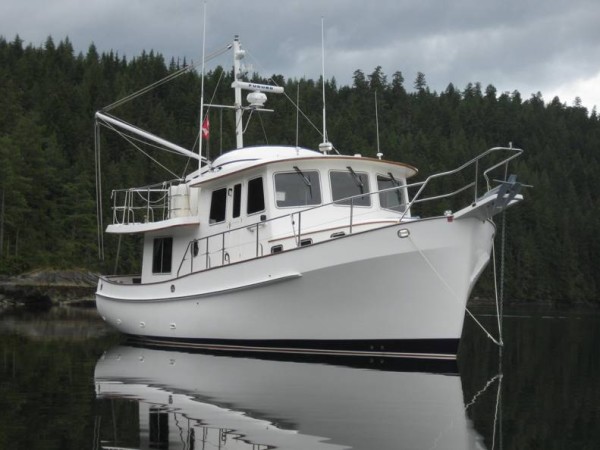

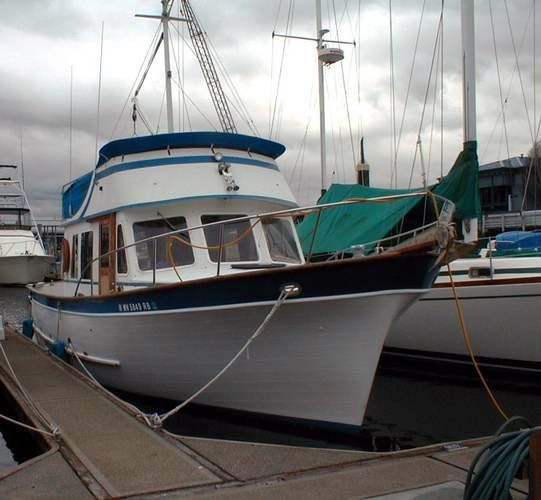



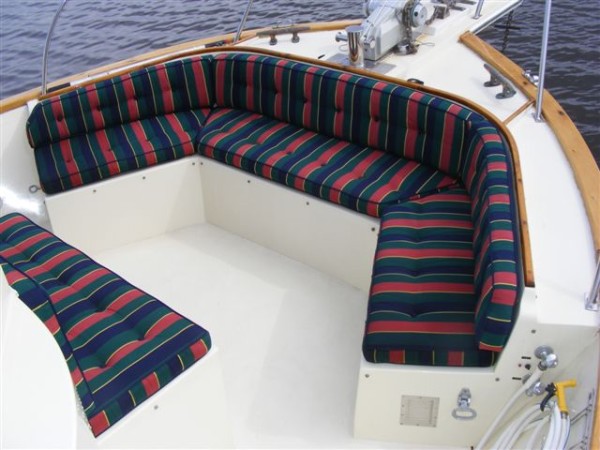
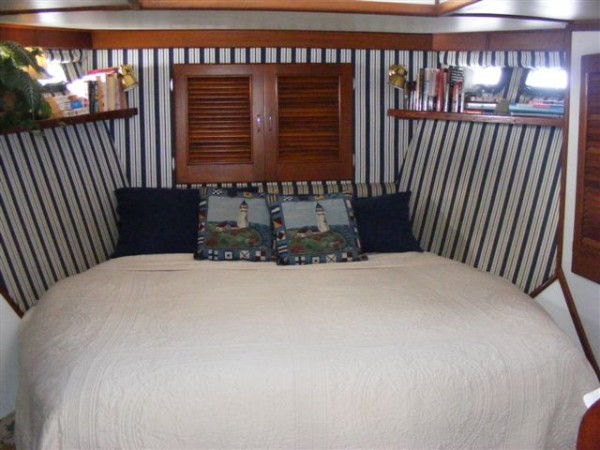
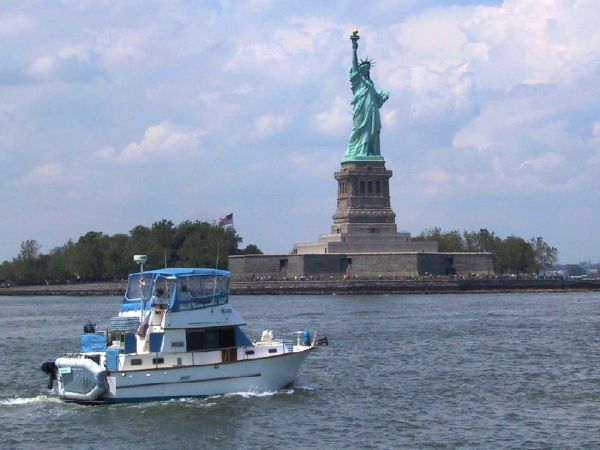
I like boats very much and the idea of living in one is something that has been tempting me for long.
I like sails because you don’t depend on oil, but like trawlers because they’re easier to operate.
It’d be interesting to see if they could be fitted with an electric motor for propulsion and have the batteries pack charged with solar. It may not run non-stop for long, but it could intermitently indefinitely.
I hope to live in a boat someday.
Thanks for the post! 🙂
A couple of links to get the imagination going: http://www.solarnavigator.net/solar_boats.htm http://www.solarnavigator.net/dse_island_pilot_hybrid.htm for a diesel/solar/electric motoryacht. I’m sure the price is completely frightening, but if the technology exists some tinkerer will make one themselves from spare junk.
All that space would be nice. We cruise in the summer in a 23.5 foot Bayliner, but our speed is about double which gets us there quicker. But our smaller size limits where we can go and the kind of weather we can stand. Nice post.
I have always dreamed of living on a boat and crusing, that would be fantastic. But it is kind of 180 degrees from a tiny home as far as money savings goes I think, it seems that way anyway. On a boat you would have fuel, tons of maintence, yearly antifouling paint, etc to worry about. I would love to be able to afford that though!
Check your facts on trawler style boats. They don’t go 20 knots as you say. They are a displacement hulls and are slow and energy effiencient… well as boats go. I’d say this trawler cruises at 9 knots but could top out at 12 kts using twice the fuel!
Displacement hulls have a maximum hull speed dictated by their waterline length. The longer you faster you can go. When you exceed the hull speed you need massive amounts of power to go only slightly faster.
Well, as the child of a commercial fisherman I am here to tell you that the saying is true, a boat is a pit you through money into.
This is nothing remotely like small house living.
Actually Anderson, the saying is that boats are a hole in the water you throw money into. And boats can very well be much like small house or RV living. They can sometimes even be cheaper to dock than an RV is to park. As to the sail problem, many trawlers can be fitted with simple mast arrangements and a converted motor sailor is the result, although a dedicated one is best to start off with. There are thousands of good quality boats like this that can be had for next to nothing in some parts of the world, shopping is fun also.
Although the boat featured in this article is really nice with that rich, cozy feel … that boat (okay, most any boat) is cost prohibitive to my meager budget. 🙂
Solar burrito. Thanks for the additional info. It looks like both displacement and semi-displacement hulls are both becoming popular with recreational trawlers. Wikipedia has some good info.
Christina – All the boats above are displacement hulls, not semi-displacement. If you have a semi-displacement hull it’s no longer a traditional trawler. I’d call it a cruiser at that point. I know boats from experience. Trawlers could be fuel efficient for a boat, but as soon as you start to plane or semi-plane in a semi-displacement boat, you start bleeding money really quickly. Imagine 2 huge gas or turbo diesel engines sucking down enough gas to push thousands of lbs of water out of the way to get above it. You really have to pay to play if you want to get your live aboard cruiser up to 20kts. My point is the boats above don’t do 20 kts, even if they do it’s not their cruising speed.
I will say that not all boats HAVE to be money pits but it’s because boats vary so much in size, type, use, engine configuration, weight etc. For instance my 18′ boat on a trailer in my backyard costs almost nothing to store/park all year. But If I had one of the 45′ trawlers above, it would cost $300 a month just to moor/park near Seattle, then my maintenance costs would sky rocket as they sit in salt water their whole life and need bottom paint every 1-3 years. An expensive toxic paint that requires the boat be lifted out of the water with a large crane and placed on the hard for a boat yard to paint. Any of this sound cheap?
I find the topic very interesting…thanks for everyone’s comments.
I live in the desert now but dream of someday spending much of my time on the water.
The most efficient speed in knots (in the sense of fuel used per nautical mile travelled) for a traditional displacement hull is roughly the square root of the length in feet. A 36 foot Grand Banks for instance, gets the best mileage at about 6 knots. I’ve heard it’s around 1 1/2 gallons per hour, a small 40-50 horsepower diesel. Not bad for boat that size.
I have recently begun to see more and more people interested in boats for their summer homes, I love learning more and more about this trend!
Ultimately Motoryachts are truely top notch quality and offers maximum comfort however yacht owners sometimes sell them to buy or build a bigger and better one.There are no limits in quality for motor yachts and every year boat builders compete for better projects and space age interior designs. Turkey has a proven background for building top european quality yachts such as s/y maltese Falcon with cheaper prices and superior quality that nowadays many foreign customers buy or build motoryachts in Turkey. Yacht 4 Sale will always be there to protect your interests and make sure that your hard earned cash becomes nothing else but the reality of your dreams
Interesting, some of the comments are better than the story. I personally live on a 32 foot (14 wide) Delta, pocket seiner. My 3208T Cat engine pushes the boat at 8 knots with a fuel consumption of 4 gal an hour; not really bad for short runs but can add up on a long journey. I have lived on this vessel for six years, lived on others before it and wouldn’t live on land if you gave me the house for free. There is nothing like the peace you feel when living on the sea, also I have more cash in my pocket because I don’t buy all the stuff you land-lubbers buy to fill your homes, furniture, pictures, nic naks, there’s just no room for non essentials on a boat so instead you have the cash you would have spent on them in your pocket. Also I live on the waters of Southeast Alaska, winters are tuff but summers are incredible. Probably the best part of living on the sea is the great people you meet and the unique relationship seafarer’s have with one another.
Kurt
I’ve enjoyed reading about trawlers on Tiny House Blog (a favorite blog!), and particularly enjoyed several of the responses to the article. It occurs to me that the articles on my blog at http://www.compactyachts.com might be of interest. We are dedicated to 30 foot and smaller yachts, trawlers included, which we think make splendid tiny homes!
I love the design of the first trawler pictured, the white one with the crane on the upper aft deck for the dingy. Can anyone tell me it’s manufacturer and any peculiar information about it? Thanks.
Can anyone tell me the builder of the first trawler in this article? Thanks.
Hi Bill, It’s been a number of years since you asked about the first boat pictured…so, better late then never: Kadey Krogen 48′. Cheers!